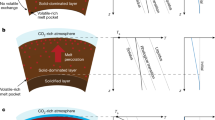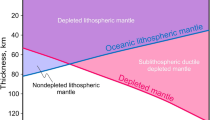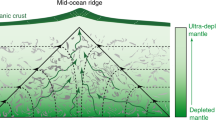Abstract
Except for the first 50–100 million years or so of the Earth’s history, when most of the mantle may have been subjected to melting, the differentiation of Earth’s silicate mantle has been controlled by solid-state convection1. As the mantle upwells and decompresses across its solidus, it partially melts. These low-density melts rise to the surface and form the continental and oceanic crusts, driving the differentiation of the silicate part of the Earth. Because many trace elements, such as heat-producing U, Th and K, as well as the noble gases, preferentially partition into melts (here referred to as incompatible elements), melt extraction concentrates these elements into the crust (or atmosphere in the case of noble gases), where nearly half of the Earth’s budget of these elements now resides2. In contrast, the upper mantle, as sampled by mid-ocean ridge basalts, is highly depleted in incompatible elements, suggesting a complementary relationship with the crust. Mass balance arguments require that the other half of these incompatible elements be hidden in the Earth’s interior. Hypotheses abound for the origin of this hidden reservoir3,4,5,6. The most widely held view has been that this hidden reservoir represents primordial material never processed by melting or degassing. Here, we suggest that a necessary by-product of whole-mantle convection during the Earth’s first billion years is deep and hot melting, resulting in the generation of dense liquids that crystallized and sank into the lower mantle. These sunken lithologies would have ‘primordial’ chemical signatures despite a non-primordial origin.
This is a preview of subscription content, access via your institution
Access options
Subscribe to this journal
Receive 51 print issues and online access
$199.00 per year
only $3.90 per issue
Buy this article
- Purchase on Springer Link
- Instant access to full article PDF
Prices may be subject to local taxes which are calculated during checkout




Similar content being viewed by others
References
Abe, Y. Thermal and chemical evolution of the terrestrial magma ocean. Phys. Earth Planet. Inter. 100, 27–39 (1997)
Hofmann, A. W. Chemical differentiation of the Earth: the relationship between mantle, continental crust, and oceanic crust. Earth Planet. Sci. Lett. 90, 297–314 (1988)
Kellogg, L. H., Hager, B. H. & van der Hilst, R. D. Compositional stratification in the deep mantle. Science 283, 1881–1884 (1999)
Becker, T. W., Kellog, J. B. & O'Connell, R. J. Thermal constraints on the survival of primitive blobs in the lower mantle. Earth Planet. Sci. Lett. 171, 351–365 (1999)
Tackley, P. J. Self-consistent generation of tectonic plates in three-dimensional mantle convection. Earth Planet. Sci. Lett. 157, 9–22 (1998)
Class, C. & Goldstein, S. L. Evolution of helium isotopes in the Earth’s mantle. Nature 436, 1107–1112 (2005)
Kurz, M. D., Jenkins, W. J. & Hart, S. R. Helium isotopic systematics of ocean islands and mantle heterogeneity. Nature 297, 43–46 (1982)
Graham, D. W. Noble gas isotope geochemistry of mid-ocean ridge and ocean island basalts: characterization of mantle source reservoirs. Rev. Mineral. 47, 247–317 (2002)
van der Hilst, R., Widiyantoro, S. & Engdahl, E. R. Evidence for deep mantle circulation from global tomography. Nature 386, 578–584 (1997)
Boyet, M. & Carlson, R. W. 142Nd evidence for early (>4.53) global differentiation of the silicate Earth. Science 309, 576–581 (2005)
Stixrude, L., de Koker, N., Sun, N., Mookherjee, M. & Karki, B. B. Thermodynamics of silicate liquids in the deep Earth. Earth Planet. Sci. Lett. 278, 226–232 (2009)
Christensen, U. R. & Hofmann, A. W. Segregation of subducted oceanic crust in the convecting mantle. J. Geophys. Res. 99, 19867–19884 (1994)
Miller, G. H., Stolper, E. M. & Ahrens, T. J. The equation of state of a molten komatiite. 2. Application to komatiite petrogenesis and the Hadean mantle. J. Geophys. Res. 96, 11849–11864 (1991)
Stolper, E., Walker, D., Hager, B. H. & Hays, J. F. Melt segregation from partially molten source regions: the importance of melt density and source region size. J. Geophys. Res. 86, 6261–6271 (1981)
Suzuki, A., Ohtani, E. & Kato, T. Density and thermal expansion of a peridotite melt at high pressure. Phys. Earth Planet. Inter. 107, 53–61 (1998)
Herzberg, C. & Zhang, J. Melting experiments on anhydrous peridotite KLB-1: compositions of magmas in the upper mantle and transition zone. J. Geophys. Res. 101, 8271–8295 (1996)
Lange, R. A. & Carmichael, I. S. E. Densities of Na2O-K2O-CaO-MgO-FeO-Fe2O3-Al2O3-TiO2-SiO2 liquids: new measurements and derived partial molar properties. Geochim. Cosmochim. Acta 51, 2931–2946 (1987)
Ohtani, E. & Maeda, M. Density of basaltic melt at high pressure and stability of the melt at the base of the lower mantle. Earth Planet. Sci. Lett. 193, 69–75 (2001)
Dziewonski, A. & Anderson, D. L. Preliminary reference earth model. Phys. Earth Planet. Inter. 25, 297–356 (1981)
Tronnes, R. G. & Frost, D. J. Peridotite melting and mineral-melt partitioning of major and minor elements at 22–24.5 GPa. Earth Planet. Sci. Lett. 197, 117–131 (2002)
Putirka, K. D., Perfit, M., Ryerson, F. J. & Jackson, M. G. Ambient and excess mantle temperatures, olivine thermometry, and active vs. passive upwelling. Chem. Geol. 241, 177–206 (2007)
Lee, C.-T. A., Luffi, P., Plank, T., Dalton, H. A. & Leeman, W. P. Constraints on the depths and temperatures of basaltic magma generation on Earth and other terrestrial planets using new thermobarometers for mafic magmas. Earth Planet. Sci. Lett. 279, 20–33 (2009)
Richter, F. M. Models for the Archean thermal regime. Earth Planet. Sci. Lett. 73, 350–360 (1985)
Korenaga, J. Urey ratio and the structure and evolution of Earth’s mantle. Rev. Geophys. 46 10.1029/2007RG000241 (2008)
Labrosse, S. & Jaupart, C. Thermal evolution of the Earth: secular changes and fluctuations of plate characteristics. Earth Planet. Sci. Lett. 260, 465–481 (2007)
Hart, S. R., Hauri, E. H., Oschmann, L. A. & Whitehead, J. A. Mantle plumes and entrainment: isotopic evidence. Science 256, 517–520 (1992)
Hernlund, J. W. & Houser, C. On the distribution of seismic velocities in Earth’s deep mantle. Earth Planet. Sci. Lett. 265, 423–437 (2008)
Mattern, E., Matas, J., Ricard, Y. & Bass, J. Lower mantle composition and temperature from mineral physics and thermodynamic modelling. Geophys. J. Int. 160, 973–990 (2005)
Stixrude, L. & Lithgow-Bertelloni, C. Thermodynamics of mantle minerals—I. Physical properties. Geophys. J. Int. 162, 610–632 (2005)
Ishii, M. & Tromp, J. Even-degree lateral variations in the Earth’s mantle constrained by free oscillations and the free-air gravity anomaly. Geophys. J. Int. 145, 77–96 (2001)
Li, L. et al. Elasticity of CaSiO3 perovskite at high pressure and high temperature. Phys. Earth Planet. Inter. 155, 249–259 (2006)
Workman, R. K. & Hart, S. R. Major and trace element composition of the depleted MORB mantle (DMM). Earth Planet. Sci. Lett. 231, 53–72 (2005)
Berry, A. J., Danyushevsky, L. V., O’Neill, H. S. C., Newville, M. & Sutton, S. R. Oxidation state of iron in komatiitic melt inclusions indicates hot Archaean mantle. Nature 455, 960–964 (2008)
Langmuir, C., Klein, E. M. & Plank, T. eds. Petrological Systematics of Mid-Ocean Ridge Basalts: Constraints on Melt Generation Beneath Ocean Ridges (American Geophysical Union, 1992)
Arndt, N. T. Komatiites, kimberlites and boninites. J. Geophys. Res. 108 10.1029/2002JB002157 (2003)
Grove, T. L. & Parman, S. W. Thermal evolution of the Earth as recorded by komatiites. Earth Planet. Sci. Lett. 219, 173–187 (2004)
Bina, C. R. & Helffrich, G. R. Calculation of elastic properties from thermodynamic equation of state principles. Annu. Rev. Earth Planet. Sci. 20, 527–552 (1992)
Ohtani, E., Kawabe, I., Moriyama, J. & Nagata, Y. Partitioning of elements between majorite garnet and melt implications for petrogenesis of komatiite. Contrib. Mineral. Petrol. 103, 263–269 (1989)
Sakamaki, T., Suzuki, A. & Ohtani, E. Stability of hydrous melt at the base of the Earth’s upper mantle. Nature 439, 192–194 (2006)
Agee, C. B. Static compression of hydrous silicate melt and the effect of water on planetary differentiation. Earth Planet. Sci. Lett. 265, 641–654 (2008)
Connolly, J. A. D. & Petrini, K. An automated strategy for calculation of phase diagram sections and retrieval of rock properties as a function of physical conditions. J. Metamorph. Geol. 20, 697–708 (2002)
Acknowledgements
The ideas for this paper were conceived at Rice University and fine-tuned at the 2008 Cooperative Institute for Deep Earth Research workshop at the Kavli Institute. We thank G. Masters, M. Ishii, M. Manga, M. Jellinek, B. Romanowicz, T. Plank, H. Gonnermann, L. Stixrude and C. Lithgow-Bertelloni for discussions and S. Parman for reviews. G. Masters also helped with velocity calculations. We thank the Packard Foundation and the NSF for support. J. Li also acknowledges support from the University of Illinois.
Author Contributions C.-T.A.L. planned the paper, performed the modelling and wrote the paper; P.L. helped with the modelling and interpretation and figures; T.H. helped with the geodynamic interpretation; J.L. helped with the density modelling and interpretation; R.D. helped with the petrologic and geochemical interpretations; and J.H. helped with the geodynamic and mineral physics interpretations.
Author information
Authors and Affiliations
Corresponding author
Ethics declarations
Competing interests
The authors declare no competing financial interests.
Rights and permissions
About this article
Cite this article
Lee, CT., Luffi, P., Höink, T. et al. Upside-down differentiation and generation of a ‘primordial’ lower mantle. Nature 463, 930–933 (2010). https://doi.org/10.1038/nature08824
Received:
Accepted:
Issue Date:
DOI: https://doi.org/10.1038/nature08824
This article is cited by
-
Earth’s mantle composition revealed by mantle plumes
Nature Reviews Earth & Environment (2023)
-
Moon-forming impactor as a source of Earth’s basal mantle anomalies
Nature (2023)
-
Effects of depth- and composition-dependent thermal conductivity and the compositional viscosity ratio on the long-term evolution of large thermochemical piles of primordial material in the lower mantle of the Earth: Insights from 2-D numerical modeling
Science China Earth Sciences (2023)
-
Influence of composition-dependent thermal conductivity on the long-term evolution of primordial reservoirs in Earth's lower mantle
Earth, Planets and Space (2022)
-
Slab control on the mega-sized North Pacific ultra-low velocity zone
Nature Communications (2022)
Comments
By submitting a comment you agree to abide by our Terms and Community Guidelines. If you find something abusive or that does not comply with our terms or guidelines please flag it as inappropriate.



